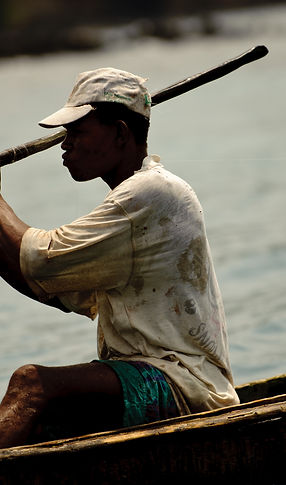BUSINESS NEWS

ECONOMY
Agriculture

São Tomé and Príncipe, although a small island nation, is recognized as one of the select countries whose Cocoa Agro-Forestry System is designated as an Important World Agricultural Heritage System (SIPAM). This system integrates essential elements, including diverse landscapes, traditional knowledge and values, biodiversity, and resilient ecosystems. Consequently, it accounts for 33% of the nation's total exports and plays a vital role in sustaining the livelihoods of its predominantly rural population.
Despite these contributions, considerable potential remains for further enhancing the utilization of this heritage, as well as for developing other organic agricultural practices, which represent the country’s primary opportunity for growth.
The agro-industry sector remains underexploited, mainly with the capability to supply entirely organic consumer goods to both domestic and international markets, all without incurring significant investment costs. Leveraging this potential could markedly accelerate socio-economic development, particularly if the principles of the creative economy are effectively implemented.
Fishery
The fisheries sector constitutes a fundamental component of the economy of São Tomé and Príncipe, and the reasons for this are evident. The maritime territory of the nation is approximately 160 times larger than its landmass, and its geographical location in the Gulf of Guinea is advantageous, complemented by climatic conditions that support a diverse array of marine resources. Notably, the fishing industry contributes 33% to the gross domestic product (GDP) and employs approximately 5% of the population; however, it remains largely under-exploited. The national fishing fleet primarily consists of artisanal and semi-industrial vessels that rely on traditional fishing techniques.
Current estimates suggest that the annual potential catch ranges from 37,000 to 45,000 tons, while the actual yearly catch is approximately 15,000 tons.
For the fisheries sector to play an even more significant role in the local economy, industrialization of the industry and enhancement of local product processing are essential. Such developments would serve to improve the fisheries value chain and mitigate post-harvest losses.

Tourism

São Tomé and Príncipe is characterized by their lush, unexplored natural environment, surrounded by pristine waters and dense rainforests. It holds a significant position as one of the most biodiverse nations globally, which provides a substantial competitive advantage in the development of nature-based tourism compared to other destinations. Presently, tourism constitutes approximately 33% of the nation’s GDP and supports around 15,000 jobs, contributing an annual income of roughly USD 5 million. However, the sector's potential remains underutilized, particularly in terms of diversifying tourism offerings.
The tourism industry possesses considerable capabilities to foster socio-economic development within the islands, provided that it is developed sustainably. The available resources for such development are abundant. The expansive maritime territory, along with the crystal-clear, warm waters that border the coastlines, presents favorable conditions for water-based recreational activities, which are currently minimal in the country.
The tropical rainforests, known for their pristine attributes, boast rich and unique biodiversity, making them ideal for the advancement of nature-focused tourism. Additionally, the islands' diverse gastronomy and culture, shaped by the legacy of various populations, offer potential for gastronomic and cultural tourism.
Furthermore, the establishment of a creative economy anchored in sustainability could enable the innovative application of creativity and knowledge to generate novel value propositions. This approach presents a viable alternative for the socio-economic transformation of São Tomé and Príncipe.
Trade
São Tomé and Príncipe functions primarily as an importing nation, reliant on international trade to meet its economic needs. According to the World Integrated Trade Solution, the principal partners in both imports and exports for São Tomé and Príncipe include Portugal, Angola, Togo, China, Cameroon, Belgium, Italy, and the Netherlands. The primary import categories encompass capital equipment, food products, and fuel. On the export side, cocoa is the most significant commodity, constituting approximately 90% of total exports, followed by palm oil, copra, coffee, bananas, and cassava.
Product Exports
$57.1M
(2024)
Imports Per capita
$185M
(2024)
Product Imports
$185M
(2024)
Imports Growth
$185M
(2024)
Exports Per capita
$185M
(2024)
Exports Growth
$185M
(2024)
The trade sector, like other critical industries such as fishing, agriculture, and tourism, is currently underperforming and presents opportunities for improvement. To enable the trade sector to fulfill a more significant role in the nation’s economic equilibrium, it is essential to invest in prospective areas, particularly agro-processing and export-oriented fishing.


Services
The service sector, often referred to as the third sector, is a vital component of the economy in São Tomé and Príncipe, providing employment for most of the workforce and accounting for approximately two-thirds of the nation's gross domestic product (GDP). This sector includes public services, consumer services, and commercial services. The service sector in São Tomé and Príncipe is characterized by its complexity, with many individuals engaging in informal activities. While this sector shows potential for expansion, the private sector remains relatively small and fragile, primarily comprising informal businesses, micro-enterprises, and a few underfunded medium-sized formal companies. Although the private sector is vital for the country's sustainable growth, it faces significant challenges, such as inadequate financing, a lack of foreign investment, and poor infrastructure.
GEBERAL ECONOMIC INDICATORS
$
M
Gross Domestic Product (GDP) :
Consumer Price Index
Total Export :
527
450
$
39
M
160
$
M
Total Import, 2022
17
Real Interest Rate :
326
Tax Rate
Prospects
São Tomé and Príncipe has encountered significant economic challenges in recent years, which are characterized by a shortage of currency and stringent budget consolidation measures that have restricted per capita income. While economic growth has been nearly stagnant over recent years, primarily due to the absence of an extended credit facility agreement with the International Monetary Fund—an agreement that has now been finalized—the anticipated reforms are expected to catalyze growth, projecting an increase of 3.1% by the end of 2025 and 4.8% in 2026. This improvement is attributed to advancements in the energy sector, a rise in exports, tourism development, and investment in essential infrastructure. Although inflation remains in double digits, it is forecasted to decline to 5% in the medium term, which will positively impact local purchasing power. São Tomé and Príncipe possesses substantial potential for economic growth, and the government is actively implementing policies aimed at attracting foreign direct investment (FDI), generating new employment opportunities, and fostering sustainable economic development.